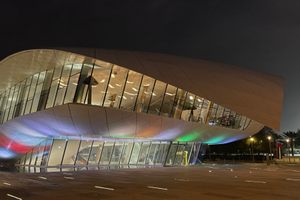
Dubai’s rise to global prominence has often led it to being one of the primary metonyms for the United Arab Emirates, a sovereign nation of which the Emirate of Dubai is a part. While Dubai and Abu Dhabi tend to dominate the spotlight, the United Arab Emirates is, in fact, a federation of seven emirates — each with its own distinct history, leadership, and culture. Before unification, these emirates existed as separate sovereign entities ruled by individual leaders.
The historic moment that brought them together took place in 1971, when the rulers of the emirates came together to sign the Constitution of the United Arab Emirates. This defining event — the raising of the first U.A.E. flag and the official formation of the nation, occurred at a site that now forms the location of the Etihad Museum
Architecturally striking and rich in symbolism, the museum was designed by Moriyama Teshima Architects to resemble an open manuscript, representing the beginning of the U.A.E.’s story. Seven towering columns are integrated into the structure, each symbolizing a pen used to sign the original declaration. The very declaration is preserved and displayed in Pavilion 6 of the museum.
The museum grounds house a remarkable collection of exhibits, including personal artifacts and original Emirati passports belonging to the founding rulers of the seven emirates. Visitors can also explore the diverse currencies that circulated in the region prior to unification, the most interesting of them being the Gulf Indian rupee, a currency created by the Indian government to combat the strain on its financial reserves as a result of gold smugglers misusing the actual Indian rupee in the Gulf during a tumultuous time when the rupee was legal tender in parts of the Middle East.
More than just a museum, this site serves as a national landmark, offering an immersive journey into the U.A.E.’s path to unity and celebrating the vision, diplomacy, and cooperation that brought the federation to life.
0 comments:
Post a Comment